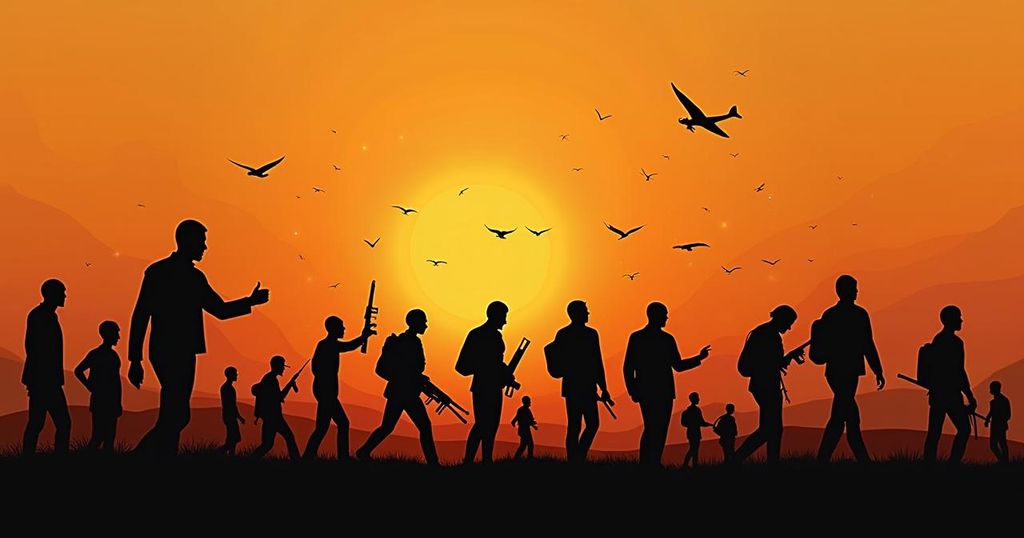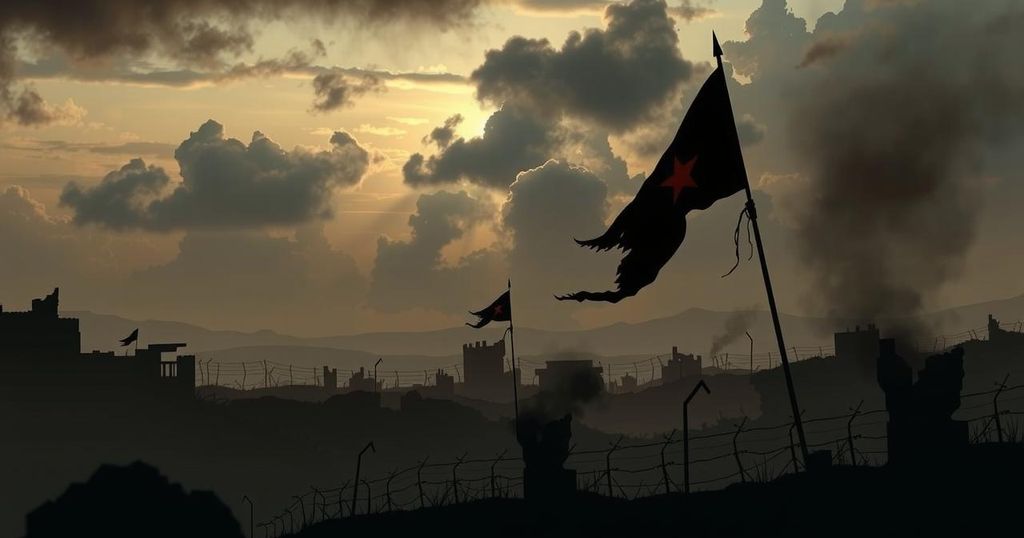Recent Developments in the Sudanese Civil War
The civil war in Sudan has escalated, with the Sudanese Armed Forces launching new offensives against the Rapid Support Forces. The conflict has resulted in over 20,000 deaths and millions displaced. Despite numerous failed ceasefire efforts and complex dynamics involving ethnic tensions and foreign influence, peace remains elusive. The humanitarian situation is dire, prompting the need for increased international mediation as regional instability grows.
The civil war in Sudan has escalated once again as of late September, with the Sudanese Armed Forces (SAF) initiating significant operations against the paramilitary Rapid Support Forces (RSF) in the capital, Khartoum, and surrounding areas. Following a period of relative quiet, the conflict has resurfaced with intensity, two years after its onset, leading to catastrophic humanitarian consequences. The United Nations reports that over 20,000 individuals have lost their lives since the war began, and the International Organization for Migration indicates that more than 10.8 million people are currently internally displaced within the nation as of October 1. Ceasefire efforts have largely failed, marking a dire situation amidst escalating violence, particularly as U.S.-led peace talks coincided with the UN General Assembly meetings. The conflict primarily pits the SAF against the RSF, rooted in a power struggle between their leaders, Abdel Fattah al-Burhan of the SAF and Hamdan Dagalo of the RSF. It commenced in Khartoum but has expanded to regions including Omdurman, Bahri, and parts of Darfur and Kordofan. Recently, military dynamics have shifted, with the RSF gaining ground in various areas, while the SAF has utilized airstrikes to reclaim territory around the capital. The humanitarian crisis deepens as access to essential aid services diminishes, causing increased suffering among civilians, especially in regions like Darfur, where famine conditions have been declared. Moreover, war crimes including sexual violence and summary executions have been reported amid the chaos. The continuation of hostilities can be attributed to several factors. First, both factions are entrenched in their positions, each seeking to consolidate power rather than seek resolution. The SAF regards itself as the legitimate governing body, having seized power through a coup in 2021, yet faces significant challenges from the RSF, which contests its claim and has garnered territorial control in critical areas. Additionally, the UN arms embargo, dating back to the 2004 Darfur crisis, remains in place but has not effectively curtailed the availability of weapons, including advanced military technology sourced from various countries. Furthermore, the warfare has evolved into an ethnic conflict, drawing in regional militias and exacerbating existing ethnic tensions, particularly in Darfur, where the RSF has been accused of targeting non-Arab communities. Compounding the urgency of the situation, external factors including alleged support from foreign military entities have contributed to the prolonged conflict. The RSF reportedly receives backing from the UAE, while the SAF has received assistance from Russia. Limited international attention and access to conflict zones have hindered mediation efforts, rendering peace negotiations ineffective. Despite numerous attempts at fostering peace—most recently in Geneva, where the SAF boycotted discussions—there appears to be no viable path towards resolution for the ongoing violence. The humanitarian situation continues to deteriorate, urging substantial international involvement and a reevaluation of strategies to address the complicated realities on the ground. As the conflict persists, the ramifications extend beyond Sudan’s borders, with many civilians fleeing to neighboring countries like Chad and South Sudan. This influx has raised alarm in Europe over potential spikes in irregular migration. Ethnic clashes have erupted among displaced populations in bordering regions, complicating an already fraught dynamic between Sudan, South Sudan, and Ethiopia. The protracted nature of the conflict in Sudan raises alarm for a potential partition akin to Libya’s situation, with the civilian population bearing the brunt of the strife. The international community’s preoccupation with other global conflicts has exacerbated the plight in Sudan, indicating that without concerted efforts for intervention, the struggle will continue amid a dire humanitarian landscape.
The civil war in Sudan began as a power struggle between two military factions—the Sudanese Armed Forces (SAF) and the paramilitary Rapid Support Forces (RSF)—but has evolved into a multifaceted conflict involving various ethnic, regional, and international dimensions. This struggle has led to significant humanitarian crises, with tens of thousands dead and millions displaced. The war’s origins date back to the military coup in 2021, which destabilized governance in Sudan and ignited violent confrontations primarily in urban settings such as Khartoum. Additionally, the involvement of foreign military support has complicated the peace efforts, fostering an environment where negotiations have repeatedly failed despite external pressure and mediation attempts.
In conclusion, the civil war in Sudan continues to present significant challenges both within and outside its borders, highlighted by failed ceasefire agreements and complex ethnic dynamics. The ongoing violence has resulted in an extensive humanitarian crisis and has implications for regional stability. As the warring factions remain entrenched in their positions, the need for renewed and targeted international mediation efforts is paramount to bring about a resolution. With rising regional tensions and humanitarian needs, the call for effective and committed international intervention cannot be overstated, lest the conflict fester further and threaten the broader Horn of Africa region.
Original Source: www.thehindu.com








Post Comment